As we stride into the vast expanse of 2024 and beyond, the ever-present hand of generative AI isn’t just rearranging the furniture in our workflows — it’s redesigning the entire house of work in the 21st century. Embracing these digital maestros doesn’t just promise smoother sailing and sparkier innovation; it’s about crafting a future of work that’s as inclusive and cozy as your favorite sweater.
With AI elbowing its way into every industry like a confident party-crasher and data being treated like the belle of the ball for decision-making, it’s no surprise that organizations are rushing to roll out the generative AI red carpet.
Whether you’re seeking enlightenment or entertainment, solutions or just plain old practicality, generative AI-powered services have got you covered. It’s like having a Swiss Army knife in your digital toolbox, ready to sculpt, create, and dazzle. And if Bloomberg Intelligence is to be believed, we’re talking a market value that could buy us all a trip to Mars by 2032 — $1.3 trillion to be exact!
But before we dive deep into the nitty-gritty of generative AI’s application, its models, tools, and all the fancy frameworks, let’s start with a casual stroll down the introduction lane. Let’s get acquainted with this digital Picasso, shall we?
Check out our latest blog on Generative AI:
Generative AI: Your Competitive Edge
What Is Generative AI?
Generative AI is a subset of artificial intelligence that utilizes advanced deep learning models and large language models (LLMs) to generate data or content. Generative AI solutions facilitate generating content like text, audio files, images, videos, and other content based on trained data and user inputs.
The question that hits many minds is how generative AI differs from other AI techniques. Traditional AI is based on receiving input and producing an output where inputted data gets analyzed and used further. Generative AI models go above and beyond the capabilities of the traditional AI in generating new information or content.
Different Types Of Generative AI Models
There are various generative AI models, each with its own approach to generating new data. These diverse models ensure delivering generative AI solutions to businesses of all scales and verticals meeting their unique needs and objectives.
Here are some of the most common types of generative AI models:
- Generative Adversarial Networks (GANs)
- Variational Autoencoders (VAEs)
- Autoencoders
- Transformer-based Models
- Markov Chain Models
- Large Language Models
- Diffusion Models
- PixelRNN and PixelCNN
- Flow-based Models
Gartner estimates that about 80% of enterprises will have used GenAI APIs and models by 2026 and/or deployed Generative AI applications in the production environment.
Applications of Generative AI
Applications of Generative AI encompass a wide range of industries and use cases, leveraging the ability of generative models to create new data or content that is realistic and representative of the original dataset. Here’s a detailed exploration of some key applications:
Popular Libraries and Frameworks for Generative AI:
Here are popular libraries and frameworks widely used by data scientists for implementing generative AI solutions and models.
TensorFlow: Developed by Google Brain, TensorFlow is an open-source machine learning framework used for training and building deep learning models. TensorFlow Offers a high-level API for easy model building and a low-level API for grained control over model architecture and training process. It facilitates developers to efficiently design, deploy, and scale machine learning applications.
Providing an extensive ecosystem of tools, libraries, and resources TensorFlow is a widely used framework to develop progressive machine learning models across diverse domains such as computer vision, NLP, reinforcement learning, and more. Known for its flexibility and scalability, supporting various platforms and deployment environments, including desktops, servers, mobile devices, and cloud computing platforms TensorFlow offers support for both research and production workflows.
PyTorch: Offering flexibility and easy usability, PyTorch is a robust open-source machine learning library developed by Facebook’s AI research lab (FAIR). The dynamic computational feature offered by PyTorch makes it a popular choice among developers. It enables users to define and modify computational graphs on the fly allowing for more intuitive model building and debugging.
PyTorch’s eager execution model enables users to receive immediate feedback during model development facilitating rapid iteration and experimentation. While building generative AI models PyTorch allows seamless integration with Python simplifying the development process. This framework offers a comprehensive set of functionalities for building and training neural networks, including support for automatic differentiation, various optimization algorithms, and GPU acceleration.
Keras: Keras provides a user-friendly interface to build, train, and deploy deep learning models with minimal code. Written in Python, it is a high-level neural network API designed for ease of use and flexibility. Allowing developers to prototype and experiment with various neural network architectures quickly, Keras is an ideal choice for both beginners and experts.
The modular design of Keras enables seamless integration with other popular deep-learning libraries. This integration provides access to a wide range of advanced functionalities removing the complexities of low-level implementation details. Developers providing generative AI solutions can focus on designing and trying new things with multiple neural network architectures instead of getting stuck in boilerplate code.
GANs Libraries: Generative Adversarial Networks (GANs) libraries facilitate the creation, training, and evaluation of GAN models. It is a branch of machine learning algorithms used for generating new data samples resembling the given dataset. GANs Lab is a platform used for experimentation, development, and deployment of GANs.
GANs libraries enable users to tackle a variety of generative tasks across different domains, including image synthesis, text generation, and audio generation. It offers versatility and scalability to the generative AI models. By harnessing the computational capabilities of modern GPUs and distributed computing frameworks, these libraries empower developers to efficiently train large-scale GAN models on enormous datasets.
Scikit-learn: Scikit-learn is a machine learning library used by generative AI solutions providers offering an efficient tool-set for data mining and data analysis tasks. Built on top of NumPy, SciPy, and matplotlib, Scikit-learn is developer-friendly and can be integrated with other libraries seamlessly. It offers rapid prototyping with simplified API and experimentation with ML models.
Offering a comprehensive range of supervised and unsupervised learning algorithms, including classification, regression, clustering, dimensionality reduction, and model selection, Scikit-learn is an ideal choice for both beginners and experienced data scientists. With its consistent interface and extensive documentation, developers can easily apprehend the fundamentals of machine learning and apply various algorithms with minimal effort.
Benefits Of Leveraging Generative AI Models For Businesses
Boosted product development: Generative AI solutions enhance the ability to expedite and elevate product development processes. It swiftly generates diverse design variations, prototypes, and simulations, empowering businesses to explore a vast array of possibilities.
Operational streamlining: Generative AI models enhance operational efficiency by automating tasks, optimizing processes, and furnishing valuable insights. It aids in identifying blockades, streamlining workflows, and enabling data-informed decision-making.
Data-driven strategizing: Leveraging generative AI models’ prowess in generating scenarios, forecasts, and insights based on data, businesses can make more informed, data-driven decisions. This equips organizations with invaluable insights to comprehend trends, anticipate market shifts, optimize resource allocation, strategize marketing tactics, and mitigate risks, thereby enhancing strategic planning and decision-making processes.
Deepened customer understanding: Generative AI solutions enable organizations to gain deeper insights into customer preferences, behaviors, and market trends. It facilitates the comprehension of customer sentiment and identification of emerging patterns, thereby uncovering valuable insights for product development, marketing strategies, and customer service enhancements.
By 2025, 10% of all global data produced will come from generative AI. (Gartner)
Economical and time-efficient: The generative AI model facilitates cost reduction and time savings through task automation and synthetic data generation. It eliminates the need for manual data generation, diminishes dependency on physical prototypes, and streamlines iterative design workflows.
Personalized customer engagements: Generative AI solutions facilitate the delivery of personalized customer experiences by capturing individual preferences and generating bespoke recommendations, content, or offerings. This tailored approach can elevate customer satisfaction, foster deeper engagement, and cultivate enduring customer loyalty.

Competitive differentiation: Leveraging generative AI solutions awards a competitive advantage, empowering businesses to innovate, differentiate their offerings, and provide unique features or customization options that distinguish them from competitors.
Conclusion:
Harness the power of generative AI models to deliver superior customer experience and streamline day-to-day business operations. From making informed decisions to content generation- take creativity and creation to whole new heights with generative AI solutions. Businesses willing to stay ahead of the curve and competition are looking forward to Data Science and Generative AI solutions.
Give your business a competitive edge with generative AI models to offer your target audience beyond their expectations and industry standards. Contact our data experts to get life into your ideas and concepts leveraging the full potential of generative AI solutions for your business.


No comments yet